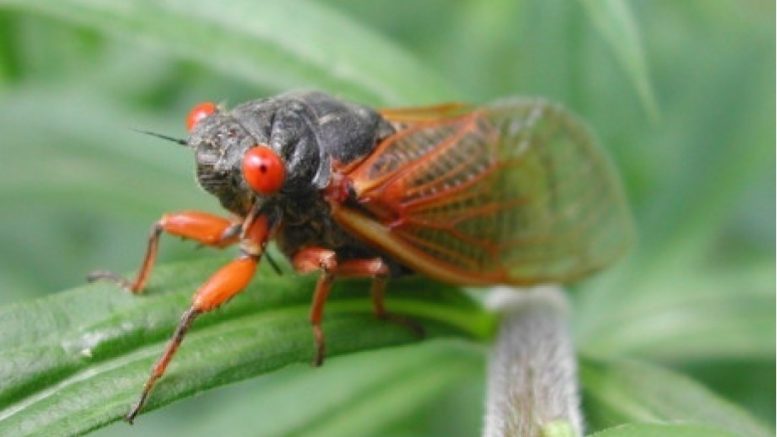Imagine sharing your yard with thousands of teenaged periodical cicadas! These fascinating insects have been harmlessly feeding on tree roots for the past seventeen years. Finally, they emerged to become adult bugs with big redeyes and orange-veined wings. What will they do to our neighborhood, to our trees, and, most importantly to us? What should or should we not do to these creatures? Read on to learn about the life history of these unique native insects without all the media hype.
The media is telling us that in the spring of 2021 there will be trillions of periodical cicadas swarming over fifteen states. Within Pennsylvania, we can expect these bugs in forty of our sixty-seven counties. Is this true? Well yes, but with great limitations! If you are lucky and that’s my point of view, you may experience an exciting and natural event that occurs in very few areas only every seventeen years. Most of you will be unlucky and will not have the opportunity to experience the emergence of periodical cicadas in 2021. So, what are these creatures that are getting so much attention?
Periodical cicadas are true bugs of the order Hemiptera. They share this group with other insects with piercing-sucking mouthparts and gradual metamorphosis. This type of metamorphosis has young called nymphs, not larvae and there is no pupal stage. Other members of this group include spittle bugs, leafhoppers, and even a newcomer, the spotted lanternfly. Periodical cicadas’ closest relatives are the dog-day cicadas. These cousins are annual visitors in late summer and early fall. A friend calls them back-to-school bugs.
Periodical cicadas are among the longest-lived insects! They spend seventeen years as nymphs feeding on xylem fluids in underground tree roots without inflicting damage. There are several broods, each designated by a Roman numeral. Brood X(Brood Ten) is by far the largest. Within each brood are actually three different species: Magicicada septendecim, M. septendecula, and
M. cassinii.
What can you expect from these old, but unfamiliar friends? If periodical cicadas were in your immediate neighborhood seventeen years ago, they will probably be back again. If trees were cleared for development, their food source was removed and their population has been reduced. If periodical cicadas were not in your immediate neighborhood seventeen years ago, they won’t be there this year. These insects do not spread far from their home areas. Periodical cicada populations are described as locally abundant. Both locally and abundant are understated terms. There can be thousands of them in your yard, but none a half-mile away!
When does this emergence happen? When the soil warms in late May or early June, the periodical cicada nymphs move to the soil surface at dusk and climb up the nearest vertical surface, usually a tree trunk. In the safety of the darkness, each will molt into an adult, leaving behind a tan “shell” of exoskeleton less an inch long. The cicadas are extremely vulnerable and subject to predators at this time. Their strategy is called predator satiation. Over several nights thousands of cicadas will emerge and become food for almost every creature imaginable. Enough periodical cicadas will survive to ensure the next generation in seventeen years.
What are the thousands of one-inch long teenagers going to do in your yard? Well, the boys will sing loudly, very loudly! These boys do have a curfew: There is no singing after dark, unless you provide them with a nightlight. If a girl likes a boy’s tune, she will let him know by flicking a wing. After mating, she will move to limbs that are the diameter of pencils to insert her eggs. In six to ten weeks the tiny young cicada nymphs drop to the ground and dig down where they remain for the next seventeen years. The slits from egg laying may cause the tips of branches to wither. The injury is called flagging, which looks far worse than it is. These dead tips do not imperil a healthy tree at all. If you have very young trees, less than four years old, consider covering them with mesh netting. The mesh must be half-inch or less to exclude the cicadas. As soon as you hear the males singing, you have about a week to cover the trees before the females begin laying eggs. Generally, periodical cicadas do not lay eggs in shrubs. If you have a large landscape project planned, just delay it until July when the adult cicadas have died.
Cicadas are neither poisonous nor venomous, do not bite or sting, and do not carry diseases. They are big, clumsy fliers that may bump into you. They are only around for a few weeks and cause no harm. Discourage your pets from eating cicadas as large, crunchy exoskeletons can cause a temporary digestive upset. Managing periodical cicadas with an insecticide is not recommended. More damage is done to beneficial insects by insecticidal sprays than to the cicadas.
Those of us who love insects are excited about the emergence of Brood X. If you are not an insect lover, please be patient. Periodical cicadas are only a temporary inconvenience.
For additional details, see Periodical Cicada by Michael J. Skvarla.
This educational blog is a series of informative articles from the Penn State Master Gardeners volunteers plus news concerning the group and their activities. For more information, click here.








































